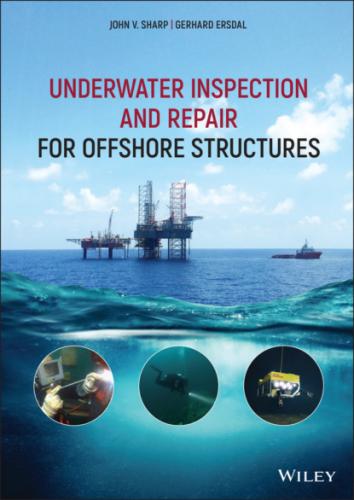Inspection is a key element of the surveillance activities and will include in‐service inspection of the structure to identify deterioration, degradation and damage. The process of identifying such anomalies will often be the most extensive and costly part of the surveillance activity (both strategy and programme).
Repair is the necessary mitigation activities in order to retain the safety of the structure if inspection has revealed anomalies of significant concern. The repair method of choice is typically based on output from a structural evaluation or assessment.
Several standards have recently been developed to guide the operators of floating facilities in their integrity management including inspection, such as ISO 19904‐1 section 18 (ISO 2006) and NORSOK N‐005 appendices F, G, H and I (Standard Norge 2017b). Further, a document prepared by Oil & Gas UK (O&GUK 2014) on the management of ageing and life extension for floating production installations provides detailed information relevant for inspection of ageing floating installations. Inspection features as a key control measure in managing the ageing mechanisms such as fatigue and corrosion, although little detail is given on the actual recommended inspection tools and technique. The main topics in the Oil & Gas UK (O&GUK 2014) are the integrity management and inspection of:
hull (structural and watertight integrity);
marine system, including ballast system, control system, cargo system, inert gas system and marine utilities (pumps, generators, etc.);
station‐keeping systems (mooring and DP).
NORSOK N‐005 (Standard Norge 2017b) builds upon this Oil & Gas UK (O&GUK 2014) report, breaks down the non‐structural systems into a number of components and identifies whether inspection based on class rules or based on generally accepted maintenance standards such as NORSOK Z‐008 (Standard Norge 2011) is appropriate.
Standards and recommended practices for SIM are given in API RP‐2SIM (API 2014b), API RP‐2FSIM (API 2019a), API RP‐2MIM (API 2019b), ISO 19902 (ISO 2007), ISO 19901‐9 (ISO 2019a), NORSOK N‐005 (Standard Norge 2017b) and HSG65 (HSE 2013). These do to a large extent include the SIM process described above.
2.3.2 API RP‐2A and API RP‐2SIM (Structural Integrity Management)
API RP‐2A has since 1969 been providing guidance for offshore structure, including surveys (inspections) during operation. The required surveys range from a minimal annual inspection (level I) to more extensive inspections at longer intervals (levels II–IV), depending on manning levels and exposure (API 1993). This approach has since been taken up by other standards. A brief overview of the required surveys required for manned and unmanned platforms is shown in Table 1.
Table 1 Inspection Intervals According to API RP‐2A (API 1993).
| Interval years for manned platforms | Interval years for unmanned platforms | |
|---|---|---|
| Level I inspectionEffectiveness of CP systemAbove water visual survey In the event of suspected underwater damage, a level 2 survey was stated to be required. | Annual | Annual |
| Level II inspectionGeneral underwater visual surveyDamage surveyDebris surveyMarine growth surveyScour surveyAnode surveyCathodic potential The detection of significant structural damage is stated to be the basis for a level 3 survey. | 3–5 years | 5–10 years |
| Level III inspectionVisual inspection of preselected areas or areas with known or suspected damageCleaning of marine growth The detection of significant structural damage is stated to require a level 4 survey | 6–10 years | 11–15 years |
| Level IV inspectionUnderwater NDT of preselected areas or areas with known or suspected damageDetailed inspection and measurement of damaged area | Dependant on outcome of level III inspection | Dependant on outcome of level III inspection |
API RP‐2SIM (API 2014b) was developed from the API RP‐2A (API 2000), ISO 19902 (ISO 2007) and industry best practices. The aim was to provide a stand‐alone recommended practice (RP) for structural integrity that clarified the link between platform data, risk categorisation, fitness‐for‐purpose (FFP) assessment and inspection. The risk categorisation depends on the likelihood of failure and the consequences from failure, in terms of manning level and environmental exposure. The risk categories are expressed as L‐1 to L‐3, with L‐1 being the higher risk platforms (typically manned or high environmental consequence).
The RP builds upon the required survey intervals as shown in Table 1 and includes a simplified risk‐based methodology for inspection planning. Further, the RP details engineering practices for the evaluation, assessment and inspection of existing fixed offshore structures to demonstrate their fitness‐for‐purpose.
The RP describes the recommended SIM process, with details of each aspect of the process, as shown in Figure 8. As can be seen, the damage evaluation, assessment process, risk reduction (e.g. repair), the inspection plan and scope are of particular relevance to this book.
Figure 8 Main SIM process of API RP 2SIM (API 2014b) and follow‐on steps.
Source: Modified from API (2014b), API RP‐2SIM Recommended Practice for Structural Integrity Management of Fixed Offshore Structures, American Petroleum Institute, 2014.
The RP requires a baseline underwater inspection to be undertaken to determine the as‐installed platform condition. The baseline underwater inspection should include a visual survey of the platform for structural damage and the presence and condition of anodes and installed appurtenances. Further, the RP requires routine underwater inspections to be conducted to provide the information necessary to evaluate the condition of the platform and appurtenances. A plan for these routine inspections, depending on the risk evaluation, is provided in API RP‐2SIM (API 2014b) giving the intervals and scope for the inspections, the tools and techniques to be used and the methods of deployment.
A simplified risk‐based approach to inspection was introduced in API RP 2SIM (API 2014b). Intervals for level II inspection were stated depending on risk levels (manning level and likelihood of failure). The risk‐based inspection programme should also specify if level III or level IV inspections are required. Damage or deterioration found during a
